This is my traditional Japanese nasu dengaku recipe. You will fall in love with it! Tender broiled eggplant slices brushed with a sweet and savory miso sauce – it’s simply irresistible and ready in just 15 minutes.
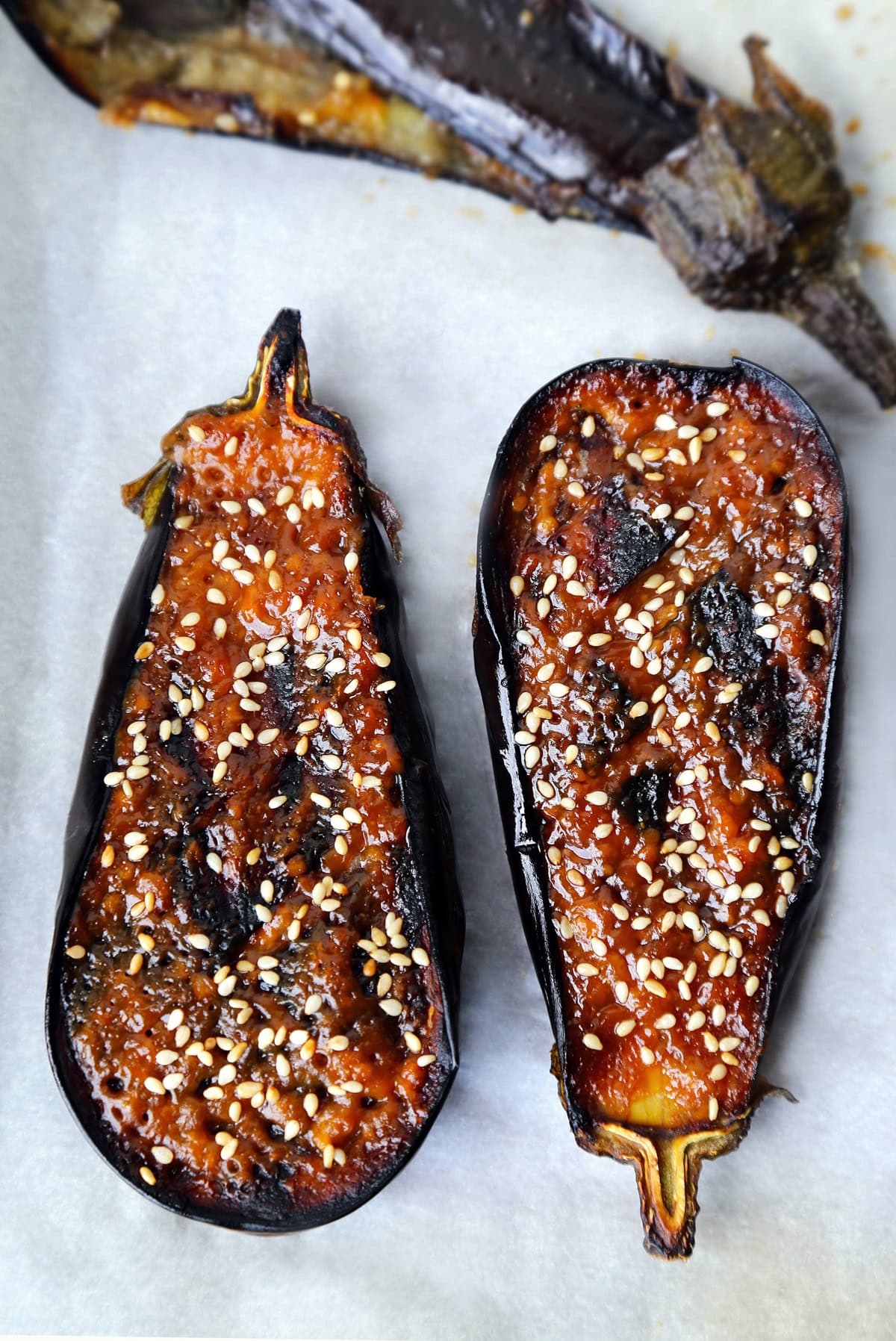
I used to have a lot of trouble cooking eggplant. No matter what I did to it, I never seemed to get it right! It either had a mushy texture or was undercooked, with that awful spongy crunch. It wasn’t until I started perusing Japanese cookbooks that I learned amazing, no fail, ways to cook delicious eggplant recipes.
Today, I’m excited to share with you the delicious Japanese eggplant dish that finally broke the curse and turned me into an eggplant expert! This nasu dengaku recipe was my first major success in cooking with eggplant, and boy is it a good one!
Table of contents
What is Nasu Dengaku?
Nasu Dengaku is a classic Japanese side dish made with eggplant sliced in half, scored and brushed with a sweet and savory miso sauce.
- The translation literally means eggplant grilled over a fire, which is exactly how it’s done in Japan.
- My version is a little different – I cook the eggplant halves for a few minutes in a skillet and finish them in a baking tray under a broiler, until the miso sauce caramelizes and bubbles.
The flavor is savory, smoky and sweet – with a toasted, nutty essence skirting around the edges. It’s SO good! Very similar in flavor to my tofu dengaku recipe.
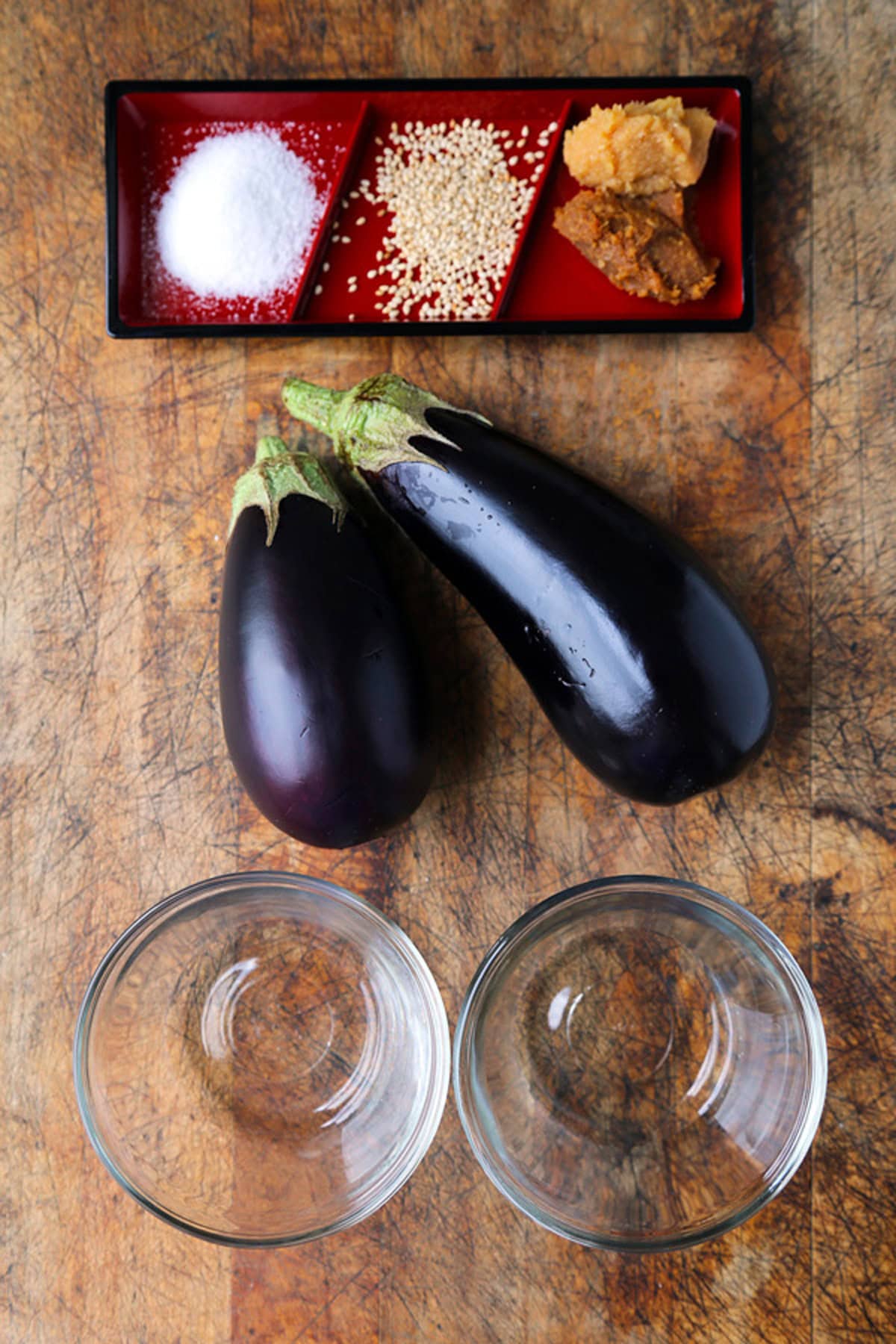
Ingredients for Nasu Dengaku
- Eggplant: When I make this dish, I like to use eggplant that are on the small side. They tend to be less bitter than larger eggplant. Male eggplants also tend to have fewer seeds. A good way to check the sex of an eggplant is to look at the bottom. Slimmer eggplants with a round indentation mark at the bottom tend to be male. Rounder eggplants with an indentation that is elongated tend to be female.
- Vegetable Oil: Any neutral flavored cooking oil will work well for this recipe.
- Miso Paste: Miso paste is the key ingredient in this miso eggplant dish. Miso paste is a fermented food that is made from soybeans, salt, and koji (a type of fungus). It has a salty, savory flavor that is perfect for this dish. Additionally, miso paste is a good source of probiotics, which are beneficial for gut health. I like to use white miso paste (shiro miso) or awase miso, which is a mixture of red and white miso paste.
- Sugar: A little sugar adds a touch of sweetness without going over into cloying territory. And it also helps the sauce caramelize to perfection under the broiler.
- Mirin: This fermented rice wine rounds out the flavors in many Japanese dishes – and tempers some of the saltiness from the miso paste.
- Sake: Sake is another Japanese rice wine that is made from fermented rice. It has a dry, slightly bitter flavor that helps to balance out the sweetness of the mirin in this dish. Sake also contains amino acids, which can help add depth of flavor to the miso sauce.
- Sesame Seeds: Sprinkle a few white sesame seeds on your eggplant just before serving. You’ll love the toasted nuttiness!
Optional Toppings
Nasu dengaku is extremely flavorful on its own but can be topped with garnishes to add color and additional aromatics. Some of the most popular ones are:
- Chopped chives
- Shredded shiso leaves
- Fresh herbs such as basil or cilantro
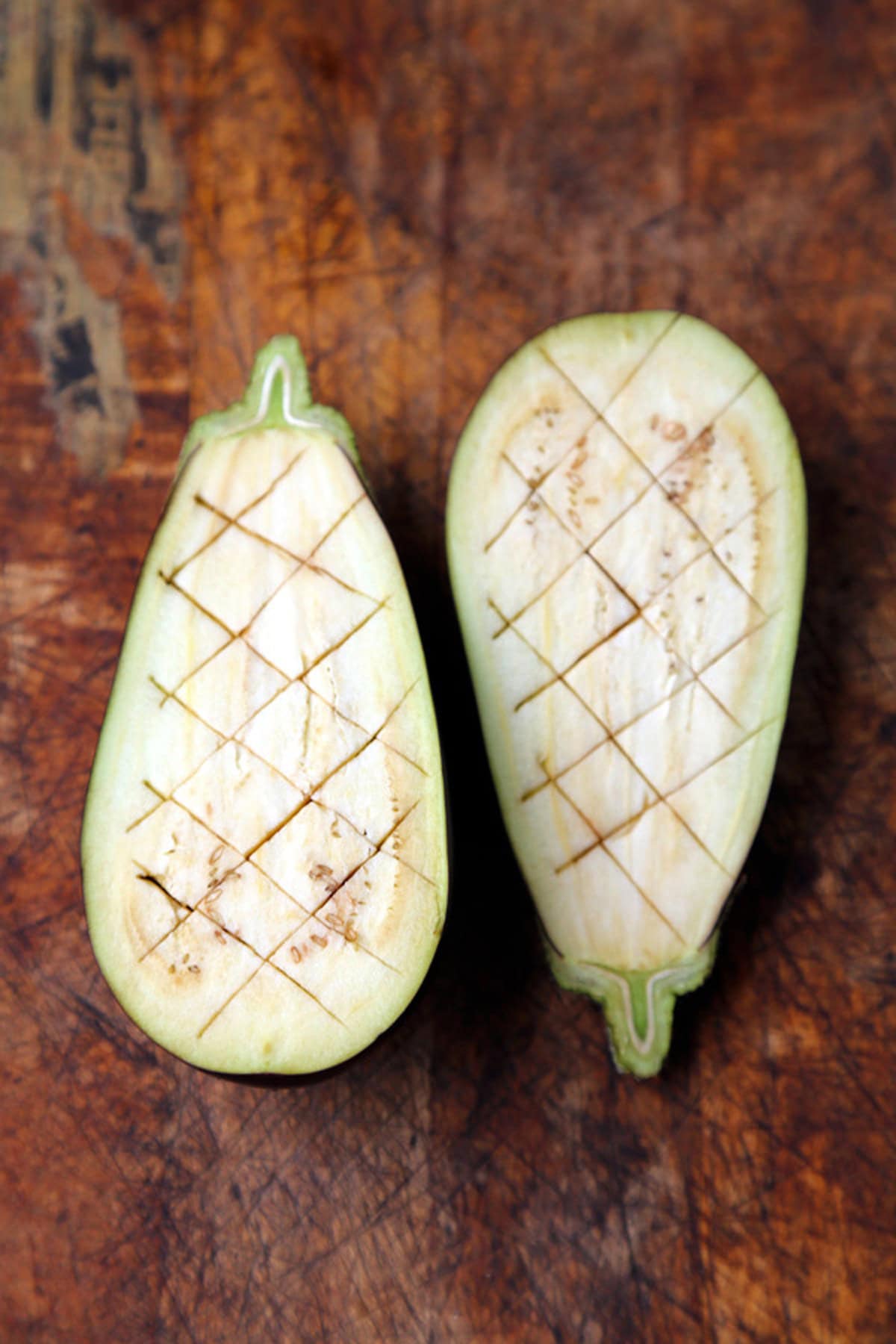
How to Make Miso Glazed Japanese Eggplant
- Prepare the eggplant. Using a sharp knife, slice the eggplant in half, lengthwise. Then score the inside flesh of each half with a knife in a criss-cross pattern.
- Cook the eggplant. Get a pan going over over high heat and add your oil to coat the bottom of the pan. Place your eggplant halves in the pan with the outer skin side facing down. Cook for a few minutes until the skin begins to brown.
- Flip it! Next, flip the eggplant over and cook with a lid on the pan on for 3-4 minutes – until the eggplant is cooked through, and the inside flesh has browned.
- Make the miso glaze. Meanwhile, whisk your miso paste, sake, mirin and sugar together in a small bowl until you achieve a smooth consistency.
- Apply the sauce. Take your eggplant halves out of the pan – and place them on top of a foil lined baking sheet with the skin facing down. Brush each piece generously on top with the miso glaze.
- Broil the nasu dengaku. Place in the oven and broil for 4 minutes. The glaze on top should be bubbling.
- Serve. Top with sesame seeds and serve it immediately.
That’s it! So easy. The eggplant will be tender and cooked to perfection. And the flavor is out of this world!
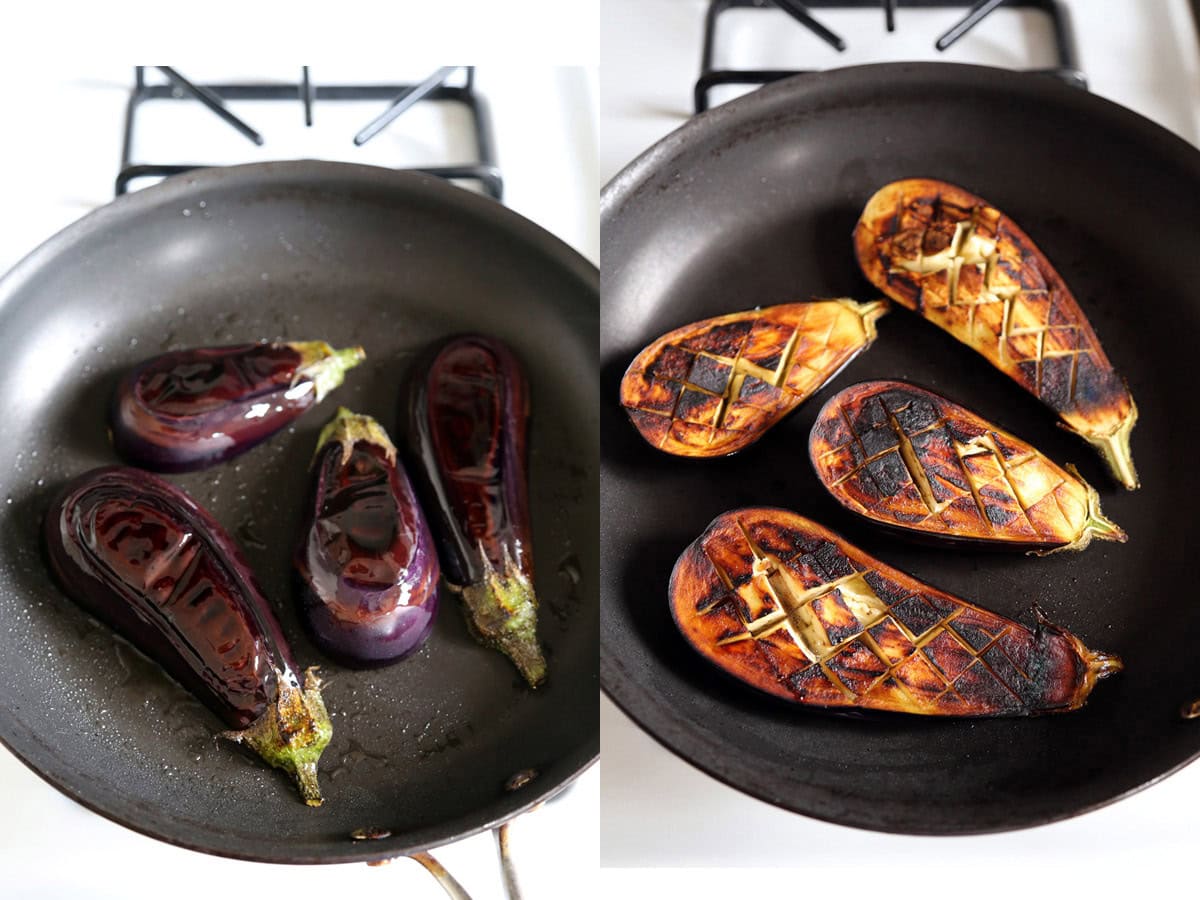
Expert Tips on Cooking Eggplant
Halving and then scoring the inside of eggplant with a sharp knife will ensure that it cooks properly in the pan.
- The trick to scoring the eggplant is to cut the inside flesh in a criss-cross pattern – without cutting the outer skin. Watch the video in the recipe card at the bottom of the page if you’re a visual learner (like me!).
Also, when pan frying, it’s a good idea to cook long enough that the flesh gets a decent amount of color on it – but not so long that it turns to mush. Remember, the final step of cooking is under the intense heat of the broiler in your oven.
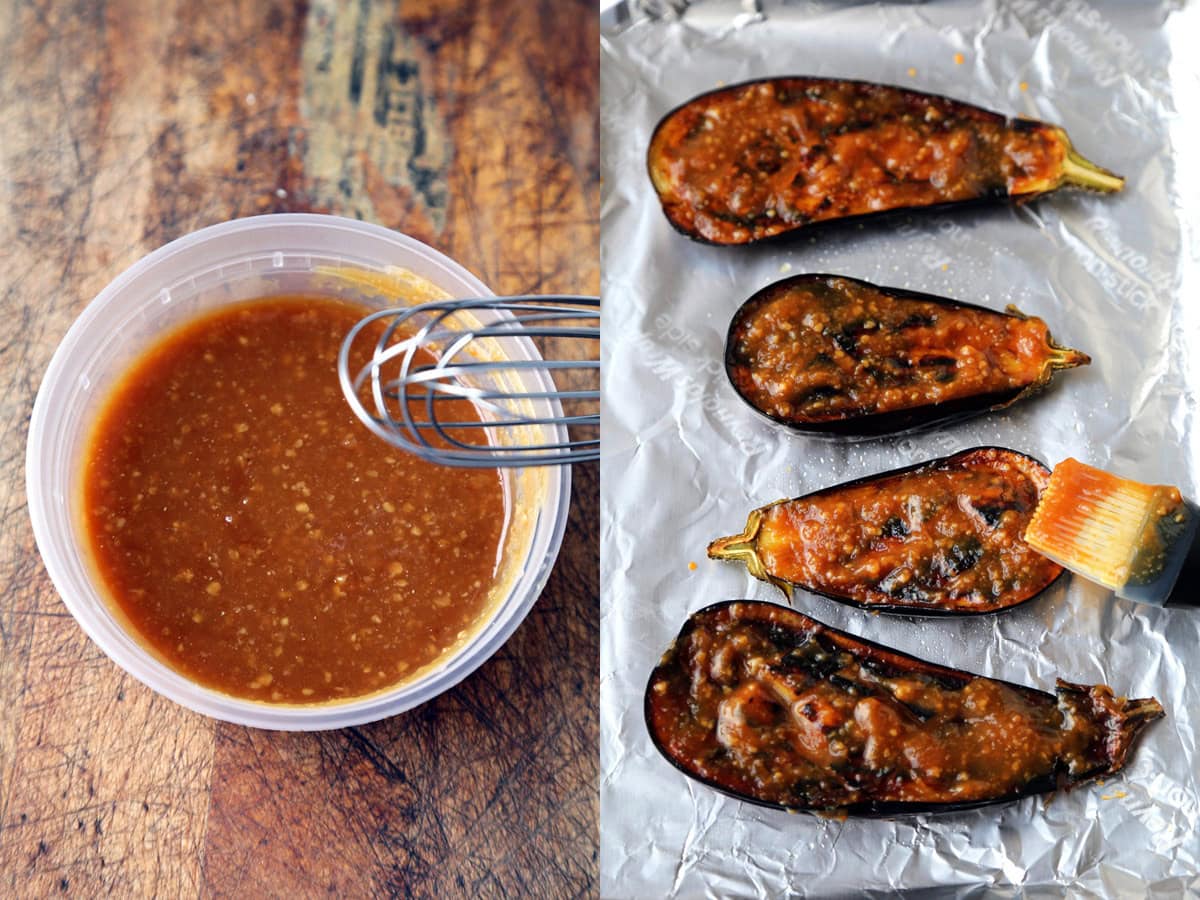
What To Serve With Nasu Dengaku
Nasu dengaku is usually served as a side dish. But it can also be enjoyed as a main course with a side of steamed Japanese rice. While I prefer eating it hot, this eggplant dish can be enjoyed hot or cold.
I love pairing it with full flavored dishes like these:
Or how about making a simple side salad and topping it with this iconic Japanese restaurant style carrot and ginger dressing? You really can’t go wrong!
And check out these other delicious and easy eggplant recipes:
- Chinese Eggplant With Garlic Sauce
- Steamed Korean Eggplant (Gaji Namul)
- Eggplant and Kabocha Miso Gratin
- Sauteed Eggplant With Spicy Miso Sauce
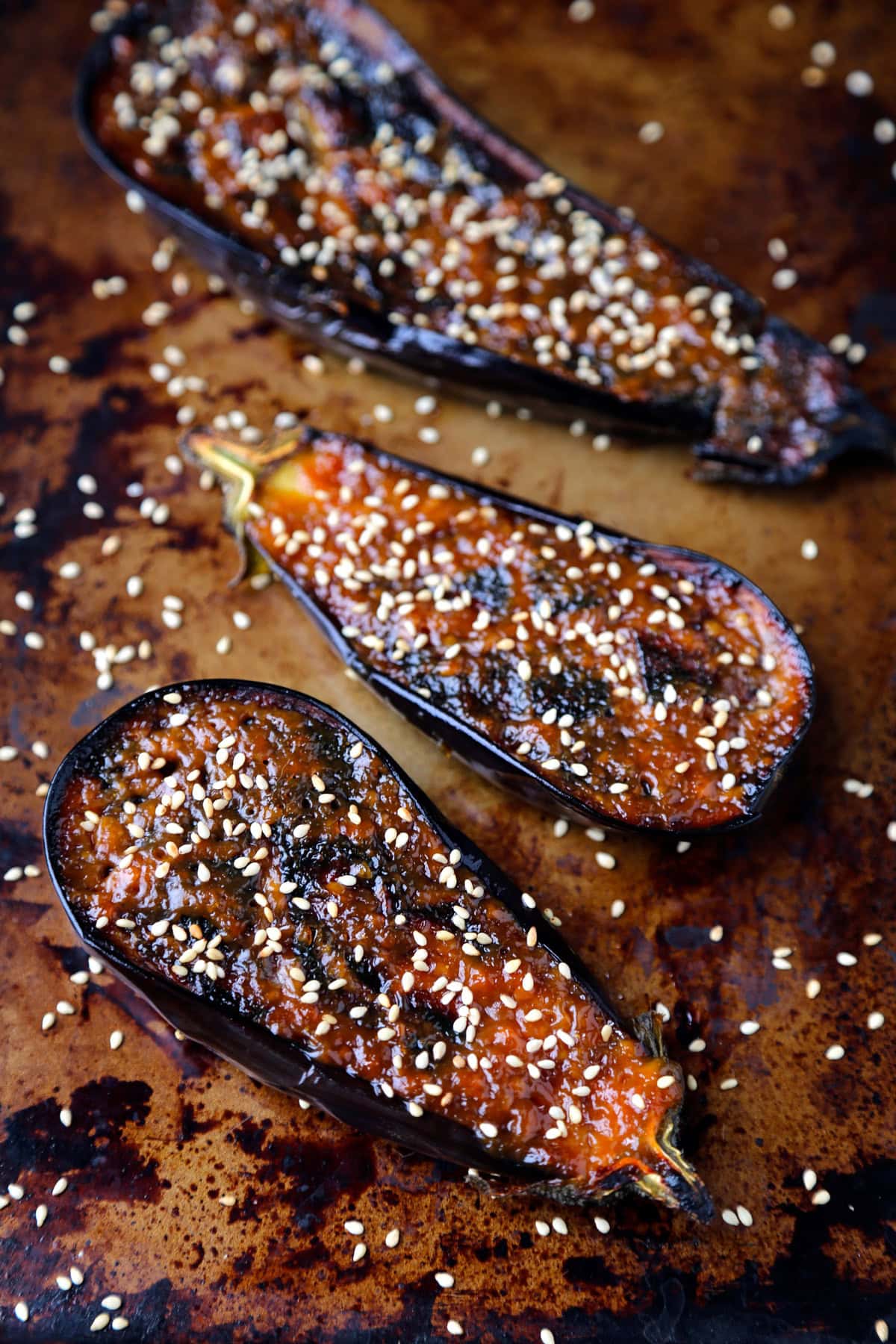
Frequently Asked Questions
Great question! The miso glaze can burn rather quickly. This is exacerbated by the sugar in the glaze. Since you’re using the broiler function in your oven, that super high heat can take things from browned to burned in no time. When I make this recipe, I keep a watchful eye – both through the oven window, and by opening the oven door to have a closer look. When the glaze is bubbling and browned, it’s good to go.
You can use dry sherry or a dry white wine, but I would use half a tablespoon instead of a full tablespoon like the recipe calls for.
Did you like this nasu dengaku recipe? Are there changes you made that you would like to share? Share your tips and recommendations in the comments section below!
Serve nasu dengaku with a side of Japanese rice. Watch my video on How To Make Japanese Rice the stove top or rice cooker method!
Print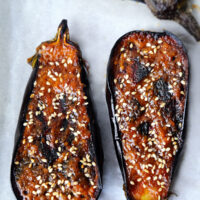
Nasu Dengaku – Miso Glazed Eggplant
- Prep Time: 5 minutes
- Cook Time: 10 minutes
- Total Time: 15 minutes
- Yield: 2 people 1x
- Category: Appetizer, Side
- Method: Pan frying
- Cuisine: Japanese
- Diet: Vegetarian
Description
A classic Japanese dish, nasu dengaku with miso glaze is sweet and savory. Ready in just 15 minutes.
Ingredients
- 2 small eggplant
- 2 tablespoons vegetable oil or other neutral oil
- 1/4 cup miso paste (I use awase miso which is a mix of both red and white miso paste)
- 2 tablespoons mirin
- 1 tablespoon granulated sugar
- 1 tablespoon sake
- Sesame seeds, for topping
Instructions
- Prepare the eggplant. Slice eggplant in half lengthwise, and score the inside in small squares (crosshatch) with a knife.
- Pan fry the eggplant. In a pan over high heat, add oil and place the eggplant outer skin facing down. Cook for a few minutes until the skin is brown.
- Flip and cover. Turn the eggplant over and cover with a lid. Cook until eggplant is cooked through (about 3 to 4 minutes).
- Prepare the miso glaze. Meanwhile, in a bowl, mix miso, mirin, sugar and sake. Whisk until mixed thoroughly.
- Glaze the eggplant. Cover a cooking tray with foil and place the eggplant on top (skin side down). Brush the miso dengaku glaze on top of each eggplant until all the surface is coated.
- Broil the eggplant. Put in the oven and broil for 4 minutes. The miso mix should be bubbling when you take it out of the oven.
- Garnish and serve. Sprinkle sesame seeds on top and serve hot.
Notes
Storage: Save leftover nasu dengaku in an airtight storage container and refrigerate for up to 2 days.
Reheating: There is no need to reheat nasu dengaku as it’s just as delicious cold! If you’d like to warm it up, reheat in the microwave on medium for 30 seconds, up to 1 minute.
Variations: Add a squeeze of lemon juice or yuzu juice for a citrus note. Add chopped scallions for a lovely crunch. Add some shredded shiso leaves or fresh basil for a refreshing, herbaceous taste.
Make it spicy: Add a little shichimi on top to add some heat, or a drizzle of chili oil.
Nutrition
- Serving Size: 1 eggplant
- Calories: 288
- Sugar: 15.6g
- Sodium: 92mg
- Fat: 15.8g
- Saturated Fat: 2g
- Unsaturated Fat: 5.7g
- Trans Fat: 0g
- Carbohydrates: 27.9g
- Fiber: 4.3g
- Protein: 4.9g
- Cholesterol: 0mg















Delicious! We all loved it!
I didn’t have sake so used dry sherry instead and it tasted like the ones I’ve had in Japanese restaurant.
I have also used it with chayote (choko) instead of eggplant, peeled and cut into 1-inch chunks. The choko needs more cooking time than the eggplant but came out yummy in the end. It’s not authentic but it tasted good and is now my favourite way to use this vegetable too.
Thank you so much, Angela!
How could you make this on a grill? I live in a camper van and do not have access to a broiler. I want the top of it to turn out right. It sounds delicious!
Hi Karen! You could get a blow torch and sear the top. The result will be very similar 🙂
If cook the eggplant in a sandwich press, and then grill it once you put the glaze on it comes out well. It may not be a 100% the same but it’s still very tasty and not far off.
This recipe was pretty tasty. I was looking for ways to use up an eggplant I got and found this recipe with ingredients I mostly had (minus the sake.) I did turn out very sweet, if I were to make this again I might try less sugar.
This was so good. I didn’t have mirin so used rice vinegar and extra sugar (per an internet substitution recommendation) and it was absolutely delicious. Will definitely make again – with proper ingredients I’m sure it will be even better!!
Hi, so I was wondering if anyone’s made this without any sake or mirin as I don’t want to use any products with alcohol. If so, did you substitute with anything?
So yummy!! I’m a vegan who loves both miso and eggplant so thought this would be right up my alley, and it totally was. I didn’t have sake so used half a tablespoon of dry sherry and an extra half tablespoon of mirin instead, which worked well. Fresh coriander on top was great with this. Served it with sourdough, a green salad, and asparagus for a perfect spring dinner. Will definitely make this one again, maybe with the silken tofu and rice next time. Thank you for the recipe!
Thank you Sara! 🙂
Can you use white miso instead of a mix of red and white miso?
Hi Katie! Yes you can absolutely use white miso paste 🙂
Absolutely adored that recipe. The eggplants (I cooked 2) were incredible. So easy to make and so delicious! Thank you!
What can I use instead of sake?
Hi Pearl! You can use dry sherry or a dry white wine, but I would use half a tablespoon instead of a full one like the recipe calls for. Or you can use a little more mirin, preferably the real mirin that has alcohol in it. I hope this helps and I hope you enjoy this recipe! 🙂
This is exactly how I remember it from Japan. Such a quick and easy recipe and so delicious. Love it!
I’m so happy you liked this recipe, Annella! Thank you for sharing 🙂
Simple and easy but good.
I love this recipe! But I wanted to ask how I could try this recipe with Chinese eggplant instead?
Hi Courtney! Yes, you can use Chinese eggplant as well 🙂
I was wondering what substitute you could what could be a substitute for the sake? It seems like an ingredient that I would use only once.
Hi Tallulah, you can use mirin instead or omit it 🙂
Great recipe, but I wonder what you’d combine this with… I love the format of a dinner made of a bunch of smaller side dishes, rice, soup, etc, so I wonder if you have any recommendations of which other dishes would go well with this?
Hi Natalia! I personally love serving nasu dengaku with a side of silken tofu (look for the hiyayakko recipe on my blog), a Japanese spinach salad (also on my blog), rice, and pickles 🙂
Hi, I actually made Karage Pork and Japanese mushrooms with it. Delicious!
I’ve attempted to make miso aubergine a few times, but this recipe got it spot on. I used a huge aubergine and left it under the grill for a bit too long, but oh boy it was absolutely delicious!
So simple, yet so delicious!
excellent
This made the perfect easy and light dinner with a little jasmine rice. Thank you! I used Korean doenjang instead of miso because that’s what I had, but I will definitely try it agin when I restock miso and I bet it will be even better.
Super easy to make, super tasty. Thanks for this great recipe and also the male vs female eggplant tip!
Made the Nasu Dengaku and it was a knock out. Many years ago, I would order this dish at a Japanese restaurant and have always wanted to make it myself. The miso glaze was just the right sweetness. It’s on our dinner plan for next week.